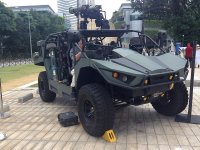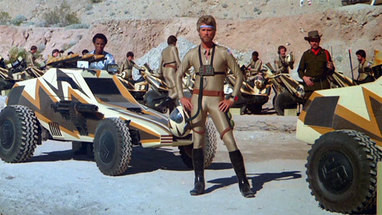Thucydides said:
While very interesting (and quite cool), this starts getting into the same area of debate Chris Pook and I have been arguing over with ATV's vs MTV's like the Bronco or BV-206. Larger vehicles are more capable and can do more things (A Bronco can be configured to carry a section with all their kit, or to be an ATGM platform, or an 81mm mortar platform, is amphibious and ari portable sung under a helicopter), but is also more expensive, physically larger and more cumbersome to deploy etc.
If we are starting to talk about fighting vehicles, then armour protection, the ability to survive IED's and possibly NBC protection should all factor in. Layering on armour to existing designs gives us monsters like the LAV 6.0, which probably represents the limits of wheeled mobility. Different thinking gives us vehicles like the Israeli "Combat Guard", which can transport a section of soldiers or be configured to other roles, can carry a RWS for self protection, is fully protected and weighs "only" 8 tons.
I will have to ask again, just what doctrinal issue is being addressed by the use of upgraded ATV's? The size upgrade of the Singapore LSV means that you can carry more useful equipment, but it is still unprotected in any meaningful sense of the word. It is also not amphibious, nor would it be capable of travelling in really difficult terrain like an MTV so you are not getting advantages like being able to operate where no one else can go. Being able to carry extra stuff is a logistical issue, but then again, having amphibious and marginal terrain capabilities provides so much more (light infantry can operate out of difficult and complex terrain far longer if their logistics vehicles can move through complex and marginal terrain as well).
And this is where one has to question whether a vehicle like the LSV can operate successfully in Canada, given the frequently difficult terrain that exists, particularly in remote areas. In provinces like Ontario, Manitoba, Saskatchewan, and a good chunk of southern Alberta, the LSV might be useful to help stand up quick reaction forces that need to strike quickly and then disappear. Most of BC, Quebec and the Maritimes offer much rougher terrain with few dirt trails, so there would be less of an opportunity to deploy a vehicle like the LSV. But then again, even the TAPV would be faced with similar difficulties in the same areas.
You could conceivably issue the LSV to PRes recce units and get substantially more cross-country mobility than you would ever get from the existing G-Wagens and MilCOTS trucks they currently have. The TAPV is a Reg Force asset and is unlikely to ever be issued to PRes recce units, save for a few that reserve units are allowed to access occasionally for training purposes.
There are several big selling features when it comes to issuing LSV's to PRes units. The biggest one being the ability to mount ATGM's, AGL's and HMG's, while G-Wagens and MilCOTS vehicles are totally unable to accommodate any of these weapon systems. The next is a large payload of 1,000 kilos, although wheeled recce units have never really needed to carry that much in the way of stores for a typical training weekend. Mind you, the large payload means that PRes recce units could become more or less self-sufficient for a significant period of time before needing to link up with service battalion units for replenishment. And since the LSV's can carry up to six soldiers, you could configure a recce squadron so that it has one organic assault troop consisting of three or four callsigns, with each callsign having two crew members and four assault troopers.
Then there is the vehicle's rapid air portability, meaning you could deploy a squadron of LSV's in a real hurry and far faster than you could ever deploy G-Wagens and MilCOTS trucks over a large area.
But the fly in the ointment, as always, and as you point out, is doctrine. If the LSV's were acquired for the PRes, how would you use them, given that PRes units generally operate as training cadres, aid-to-the-civil power resources, and augmentation for the Regular Force in overseas or other major deployments? And given those roles, do they really need the sophisticated weapon systems they can carry? I ask the question because there is very little chance that PRes units would ever see any actual combat within Canada as the country is pretty safe from invasion by a foreign power because of its sheer size, harsh climate and terrain, and the presence of the United States.
It's conceivable that they could end up deployed as part of a light rapid-reaction force overseas, but from a doctrinal standpoint, the Regular Force isn't yet configured to handle RRF missions - save for what JTF2 and CSOR can do.
As to the lack of armour protection, I don't think that is a concern that applies to the LSV. It's designed to operate as a hit-and-run type of asset, and to cope with the odd isolated tank or two it might encounter. Indeed, if a LSV crew did encounter armour, they would probably be able to engage only from well-prepared defensive positions, or a well-hidden defilade that's covered with a lot of vegetation and other natural materials.




